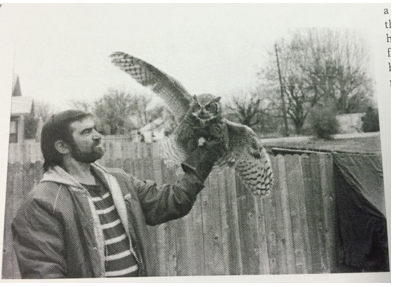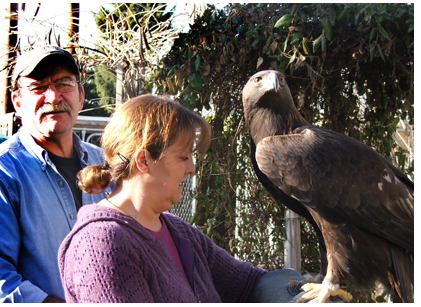
ITD Vault: 23 Years Ago
Dec. 1992/Jan. 1993
Wounded owls and hawks find a friend in Monte Tish
About a year and a half ago, Monte Tish and a friend were out hunting when they spotted a Sandhill Crane struggling on the ground not too far out in front of them. Monte and his hunting partner decided to go on hunting, and return to help the bird once they were done. But when they came back later, it was too late. Some irresponsible hunters had needlessly killed the crane while they were gone. At that point, as the blood rose hot in Monte's veins, a new chapter in his life was beginning.![]()
Not too much later, Monte and his friend were once again out hunting, and came across a wounded Great Horned Owl. This time, however, they left nothing to chance or the cruelness of fellow hunters. Tish turned right around, went back to his truck and grabbed a big gunny sack. They captured the owl and took it home to nurse it back to health.
Today, Tish, a Transportation Tech. Senior in the Materials Lab in Headquarters, is one of a very few, maybe four, licensed bird rehabilitators in the entire Boise Valley, and just one of a handful across the state. Together with his wife, younger brother and mother, he cares for birds who have been hurt and require assistance before they can be returned to the wild. It requires a special kind of commitment and compassion to be involved in bird rehabilitation, and Tish has the perfect mix. And the perfect background.
His mother raises birds, and a good fundamental knowledge of what it takes to care for them rubbed off on Monte. And as Tish explains, he has always been an avid outdoorsman, and has a great appreciation for the wild.
Currently, Tish and company care for more than 20 birds in the rehabilitation facility he has built in his southwest Boise home, including Great Horned Owls, Red Tail Hawks, a Trumpeter Swan, Marsh Hawk, Kesterol Falcon and five species of
smaller owls. So far this year he has seen about 45 birds pass through his home, and expects that this number will rise significantly soon, due to the hunting season, harsher climates and the nesting season.
It is natural, one assumes, to think that Tish might get some financial support from the Department of Fish & Game or some wildlife preservation source, but that is not the case, and that makes Tish's dedication all the more remarkable. He spent $1,000 of his own money to build cages to keep the birds out of the elements, and he estimates that another $200 per month is spent feeding, not to mention vet's bills, vitamins, and medicine.
Tish says he does get some help from a few vets that will check the birds for free, although there is no pro-bono surgery or repair offered. He also knows a butcher that donates some meat (beef hearts are a favorite), and has a few hunting friends that will give him the leftover scraps of meat from some game.
But he really doesn't mind the hardship, Tish says.
"You don't get into this unless you love animals. It's not a financial consideration. I just really enjoy doing it," he explained.
Tish considers it an opportunity, he says. He plans to embark on a series of educational tours to local elementary schools to teach bird preservation to students, hoping to instill the idea in the youngsters.
"My goal is to make kids aware of the fragility of our wildlife resources. If we can reach them young enough, we can teach them right from wrong before the wrong attitude becomes ingrained."
For anyone interested in finding out more about bird rehabilitation, Tish says there is an open invitation to come watch his operation. Any contributions, including time, are welcome.
"It's been a great experience," Tish says. "A real eye-opener."
(July 1997) Tish Raptor Rehabilitation Center – it’s for the birds
Monte Tish of the department’s Materials Section has been involved in raptor capture and rehabilitation for the last seven years.
Tish runs the operation out of his home in his spare time, feeding and rehabbing the birds until they are strong enough to be released into the wild. When Tish first began, he had a few cages in one corner of his backyard. Now, he says, there are birds all over the place. In fact, last year Tish estimates he rehabilitated and released 220-225 birds, a drastic jump from the 35 or so he saw in his first few years. So far in 1997, Tish said he has processed more than 150 birds.
Tish covers many expenses himself, although in recent years he has been able to defray some of the costs through a Pig Roast and Auction and various donations. Main expenses are food (300-400 pounds every month of chicken and beef heart), veterinarian’s bills, medicine and travel.
If you would like to get involved in helping the Tish Raptor Rehabilitation Center, contact the ESA Credit Union, Monte, or his mother, Gen, who also works with the birds. 
Editor’s 2015 Note: Tish retired from ITD in 2010. He started as a mechanic assistant with the department in March 1984. He estimates that in the last 26 years he has helped rehab about 2,500 birds and placed them back in the wild. He still works out of his home, but he moved that home to Nampa a decade ago and now resides behind city hall. Tish makes 20-60 presentations each year to school assemblies and other organizations featuring his birds. Tish has also helped with movies by PBS, Disney and Echo, filmed in the Snake River Canyon.
Pictured left is Tish in a 2010 photo, with the 26-year-old Golden Eagle he’s worked with for the last 23 years. In the wild, the birds live 25-40 years, but in the controlled environment of captivity, they can survive up to 100 years.
It was the last eagle owned by the late Morley Nelson, the famous falconer and raptor conservationist who essentially founded the Snake River Birds of Prey Center in Kuna. Also pictured is Kathy Havlina, another raptor rehab specialist. She lives in the Treasure Valley now, but will soon relocate to the Seattle area, leaving Tish as the only remaining raptor rehabilitationist in this area of Idaho.
Published 09-04-15